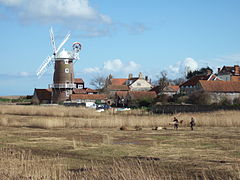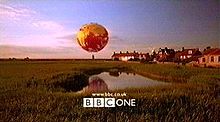- Cley next the Sea
-
Coordinates: 52°57′04″N 1°02′35″E / 52.951°N 1.043°E
Cley next the Sea 
Cley next the Sea
 Cley next the Sea shown within Norfolk
Cley next the Sea shown within NorfolkArea 8.63 km2 (3.33 sq mi) Population 608 (parish, 2001 census) - Density 70 /km2 (180 /sq mi) OS grid reference TG045436 - London 129 miles (208 km) Parish Cley next the Sea District North Norfolk Shire county Norfolk Region East Country England Sovereign state United Kingdom Post town HOLT Postcode district NR25 Dialling code 01263 Police Norfolk Fire Norfolk Ambulance East of England EU Parliament East of England UK Parliament North Norfolk List of places: UK • England • Norfolk Cley next the Sea (
 /ˈklaɪ/) is a village (population 376)[1] on the River Glaven in Norfolk, England, 4 miles north-west of Holt and east of Blakeney. The main A149 coast road runs through the centre of the village, causing congestion in the summer months due to the tight, narrow streets. It lies within the Norfolk Coast AONB (Area of Outstanding Natural Beauty) and the North Norfolk Heritage Coast.
/ˈklaɪ/) is a village (population 376)[1] on the River Glaven in Norfolk, England, 4 miles north-west of Holt and east of Blakeney. The main A149 coast road runs through the centre of the village, causing congestion in the summer months due to the tight, narrow streets. It lies within the Norfolk Coast AONB (Area of Outstanding Natural Beauty) and the North Norfolk Heritage Coast.Contents
History
Despite its name, Cley has not been "next the sea" since the 17th century, due to land reclamation. Some of the buildings that once lined the quay remain, notably the 18th-century windmill. The windmill was owned by the family of singer James Blunt for many decades[2] and operated as a bed and breakfast. The mill was sold in 2006, but continues to operate as a bed and breakfast on a non-profit making basis. It was used as a backdrop of the 1949 film Conspirator, with Elizabeth Taylor, and it features in a BBC1 continuity link. Cley Mill has often been depicted by local artists and was the subject of a painting by the 20th century English landscape artist, Rowland Hilder. Cley Old Hall was used as a location in the 1982 film The Ploughman's Lunch.
In July 1997 the BBC filmed one of its balloon idents in the village, which ran from 1997 to 2002.
It is hard to imagine Cley as one of the busiest ports in England, where grain, malt, fish, spices, coal, cloth, barley and oats were exported or imported. The many Flemish gables in the town are a reminder of trade with the Low countries.
A failed land reclamation scheme led to the silting up of the port, and Cley had to find another industry. In the late 19th century, it became a holiday resort.
 Cley Towermill stands at the edge of village, next to the coastal marshes and a network of drainage channels.
Cley Towermill stands at the edge of village, next to the coastal marshes and a network of drainage channels.
Cley Marshes
The marshes around Cley are internationally important for their populations of rare breeding and visiting birds. Cley Marshes bird reserve has been in the care of the Norfolk Wildlife Trust since 1926, making it the oldest county Wildlife Trust reserve in Britain.[3] Among resident breeding birds are Avocet, Bearded Tit, Bittern, Marsh Harrier and Spoonbill. Winter visitors include Brent Geese, Wigeon, Pintail and many species of wading birds. Cley, like neighbouring Salthouse is ideally situated at the apex of the North Norfolk coast as a staging ground for passage migrants, vagrants and rareties of all kinds. The best time for these is August, but at almost any time of year the chances of meeting a rare bird on the famous East Bank are almost as great as that of encountering a well-known bird-watcher! A new eco-friendly visitor centre opened in 2007 containing a café, shop, viewing areas (including viewing from a camera on the reserve), exhibition area, interpretation and toilets. The view from the visitor centre across the Marsh to the sea is breathtaking. Cley Marshes is the home of the Bird Information Service, publishers of Birding World. The shingle bank holds large numbers of Yellow Horned Poppy.
Sea defences
The salt and fresh water marshes used to be very well protected. However the cost of replenishing the shingle spit grew too much for the town to sustain. Once the repairing stopped, it became easier for waves to get through; in 1953 a large storm, (see North Sea flood of 1953) hit the North Norfolk coast and the shingle ridge was mostly destroyed. The North Norfolk Shoreline Management Plan introduced by the Environment Agency has proposed a number of strategies in the light of continual erosion and predicted rising sea levels caused by global warming: these include Advance the line, Hold the line, Managed retreat and Do nothing. Even after extensive public consulation there is widespread local concern that the marshes, with their unique wildlife, will be irretrievably lost to the North Sea.
References
- ^ Office for National Statistics & Norfolk County Council, 2001. "Census population and household counts for unparished urban areas and all parishes."
- ^ BBC - Norfolk - Entertainment - James Blunt interview
- ^ Norfolk Wildlife Trust - Cley Marshes
External links
- Photographs of Cley
- Cley windmill history
- Ornithologist - poem inspired by Cley
- Daily Mail article about a White-crowned Sparrow as an exotic visitor to the UK, now commemorated in the church window
Categories:- North Norfolk
- Villages in Norfolk
- Populated coastal places in Norfolk
- Civil parishes in Norfolk
Wikimedia Foundation. 2010.



